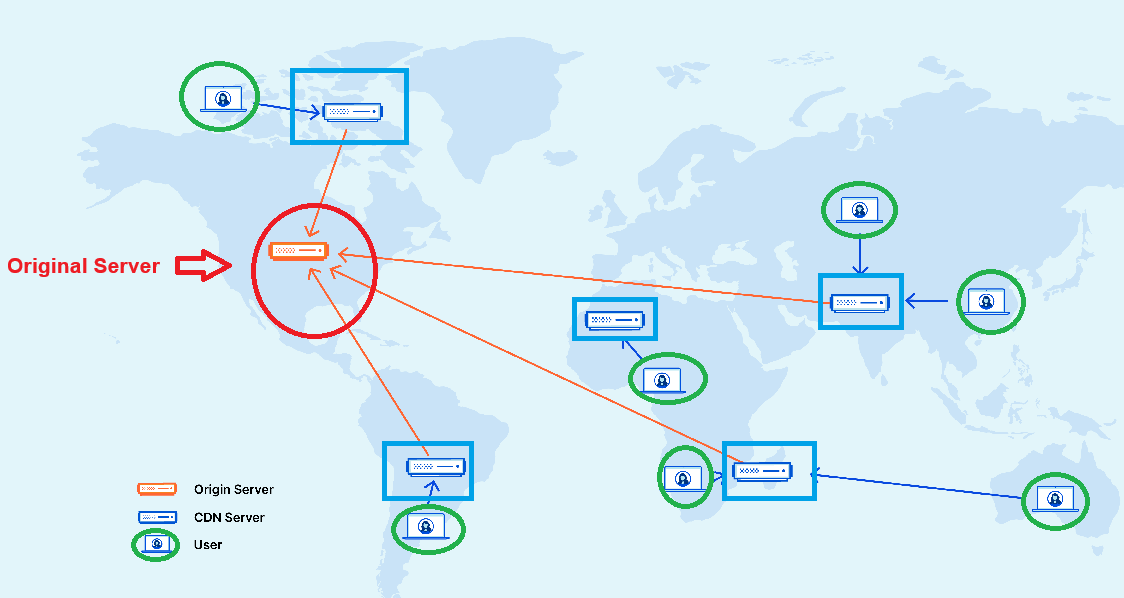A content delivery network (CDN) is a group of geographically distributed servers that speed up the delivery of web content by bringing it closer to where users are.
CDNs rely on a process called “caching” that temporarily stores copies of files in data centers across the globe, allowing you to access internet content from a server near you. Content delivered from a server closest to you reduces page load times and results in a faster, high-performance web experience. By caching content like web pages, images, and video in servers near your physical location, CDNs allow you to do things like watch a movie, download software, check your bank balance, post on social media, or make purchases without having to wait for content to load.
You could think of a CDN like an ATM. If your money were only available from one bank in town, you’d have to make a time-consuming trip and stand in a long line every time you wanted to withdraw cash. However, with a cash machine on practically every corner, you have fast and easy access to your money any time you need it.
There is no single best CDN (Content Delivery Network) provider — the right choice depends on your specific use case, such as performance needs, geographic reach, security, ease of integration, and cost.

Here’s a comparison of the top CDN providers in 2025, based on features, performance, and reputation:
🔹 1. Cloudflare
- Strengths:
- Excellent global coverage with over 300 cities.
- Built-in security: DDoS protection, WAF, bot mitigation.
- Easy setup, strong developer tools (e.g., Workers).
- Generous free tier.
- Best for: Performance + security + ease of use.
- Weaknesses: Can be overkill for simple needs.
🔹 2. Akamai
- Strengths:
- One of the oldest and most extensive CDN networks.
- Extremely reliable for enterprise-grade applications.
- Advanced security and edge computing options.
- Best for: Large enterprises, mission-critical systems.
- Weaknesses: Expensive, complex to configure.
🔹 3. Amazon CloudFront (AWS)
- Strengths:
- Tight integration with AWS services.
- Highly customizable and scalable.
- Good performance globally.
- Best for: Existing AWS users.
- Weaknesses: Steep learning curve, less user-friendly dashboard.
🔹 4. Fastly
- Strengths:
- Very fast and low latency for dynamic content.
- Developer-focused; powerful real-time configuration.
- Popular with major tech companies.
- Best for: Sites requiring real-time caching logic.
- Weaknesses: Less beginner-friendly.
🔹 5. Google Cloud CDN
- Strengths:
- Seamless integration with Google Cloud services.
- Good performance in many regions.
- HTTP/3, TLS offload, and security integration.
- Best for: Google Cloud users.
- Weaknesses: Limited customization outside GCP.
🔹 6. Microsoft Azure CDN
- Strengths:
- Integrates well with Azure platform.
- Offers options from Akamai and Verizon as providers.
- Best for: Azure-based applications.
- Weaknesses: Not as fast as Cloudflare or Fastly in some regions.
Comparison Table (Simplified)
| CDN Provider | Best For | Free Tier | Security Built-in | Easy Setup | Performance |
|---|---|---|---|---|---|
| Cloudflare | All-in-one, devs & SMBs | ✅ Yes | ✅ Yes | ✅ Easy | 🚀 Excellent |
| Akamai | Large-scale enterprise apps | ❌ No | ✅ Yes | ❌ Complex | 🚀 Excellent |
| CloudFront | AWS users, flexible control | ✅ Limited | ✅ Yes | ⚠️ Medium | 🚀 Great |
| Fastly | Real-time, dynamic content | ❌ No | ✅ Yes | ⚠️ Complex | 🚀 Top-tier |
| Google CDN | Google Cloud users | ✅ Limited | ✅ Yes | ✅ Easy | 🚀 Great |
| Azure CDN | Azure users | ✅ Limited | ✅ Yes | ✅ Easy | 🚀 Good |
Recommendation by Use Case:
- Simple websites, personal projects → Cloudflare (free + secure)
- Enterprise or high-security needs → Akamai or Cloudflare Enterprise
- E-commerce or real-time apps → Fastly
- Cloud-native stack (AWS/GCP/Azure) → Use the respective cloud provider’s CDN

A content delivery network (CDN) is a group of geographically distributed servers that speed up the delivery of web content by bringing it closer to w
[See the full post at: Top CDN Providers in 2025]
Top CDN Providers in 2025
Related posts:
Related posts: